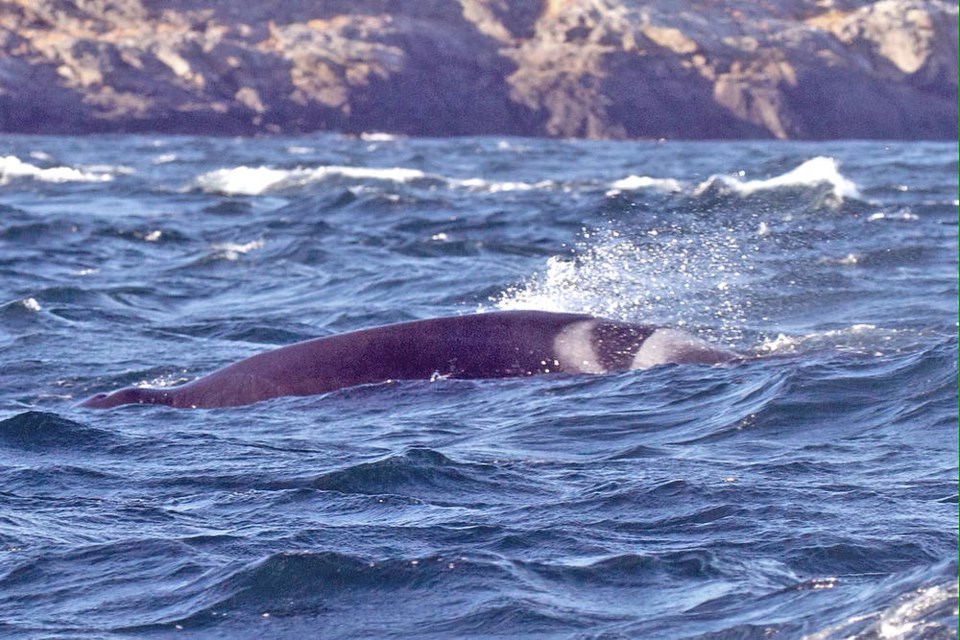The southern resident killer whales who returned to their traditional summer feeding grounds in the Salish Sea on Tuesday and Wednesday after a long absence have apparently left again.
Researchers say it’s a sign that chinook salmon, their main food source, is scarce and they’ve gone elsewhere — again — to look for food.
And although most of the members of J-, K- and L-Pods appeared to be healthy, at least one may be close to starvation.
Rosie Poirier, program co-ordinator for Straitwatch — a marine mammal monitoring and education program that has been keeping tabs on the endangered southern residents on behalf of the Department of Fisheries and Oceans — said a 35-year-old male orca known as K21 showed severe signs of malnutrition and likely won’t survive.
“The condition of K21 as seen [Wednesday night] is alarming,” said Poirier, who noted, however, that male orcas live 30 to 50 years on average.
“His condition, until the cause is confirmed, may not be indicative of the current health of other individuals in his pod.”
Poirier located K21 at 6:30 p.m. in the Strait of Juan de Fuca and monitored him for two hours until the DFO Whale Protection Unit arrived.
“The lone male had been left behind by the rest of its pod earlier in the day,” she said. “Its dorsal fin was completely flopped at the base and it had the worst case of ‘peanut head’ that I have ever seen, a sign of starvation.”
“Peanut head” means the head shows deep indentations as a result of lack of fatty tissues, revealing the shape of the orca’s skull.
Poirier said K21 was labouring against the current and made only 1,000 metres of headway during the two hours she monitored him before darkness fell.
“[K21] is likely to die very soon,” she said.
The last southern resident orca to show these symptoms was J50, a four-year-old female known as Scarlett, who died in 2018 despite unprecedented attempts by scientists to feed and inject the animal with antibiotics.
Reached on a research vessel in Juan de Fuca Strait Thursday afternoon, Poirier said K21 and the other resident orcas have not been seen since their appearances around the San Juan Islands and Sooke.
The Straitwatch team picked up on J-Pod outside Sooke Harbour on Tuesday in the fog around noon and monitored them until they neared Constance Bank in the evening before they were lost in the dense fog.
Poirier managed to take photographs for identification, but wasn’t able to confirm the presence of all the members of J-Pod.
J-Pod was picked up on Wednesday evening on the Lime Kiln Hydrophone off the west side of San Juan Island (their traditional summer feeding grounds). L- and K-Pods were confirmed in the Salish Sea later in the day.
Poirier said at least two of the three calves born to J-Pod over the last two years were confirmed. The third may not have been visible due to the fog. The pod appeared to be in good shape and was very social throughout the day, she said.
J-Pod’s visit was brief after a record absence of more than 108 days, which indicates there is not enough salmon to sustain them during the summer months in the Salish Sea anymore, said Poirier.
“They are having to adapt and change their foraging behaviours and to look for food elsewhere,” she said, adding that should be a call to action to improve salmon conservation efforts.
“Orca, as an apex predator, are an indicator species for the health of an ecosystem. Their lack of presence in the Salish Sea indicates an imbalance in the food chain as salmon stocks continue to plummet.”
Only 74 southern resident killer whales remain.
dkloster@timescolonist.com
- - -
To comment on this article, send a letter to the editor: letters@timescolonist.com



